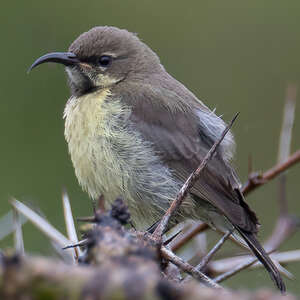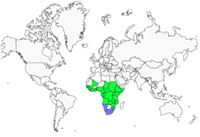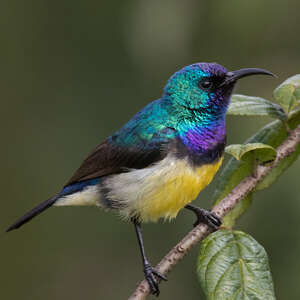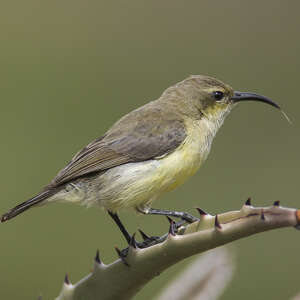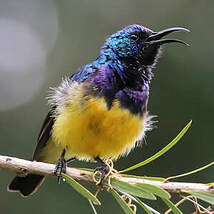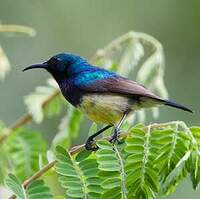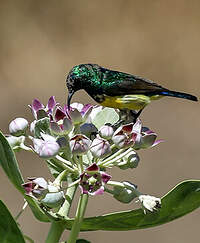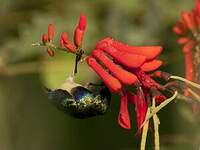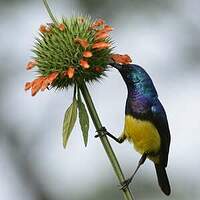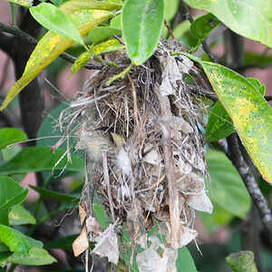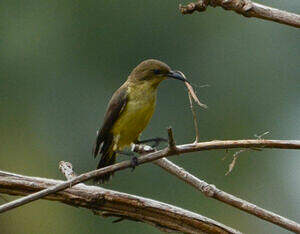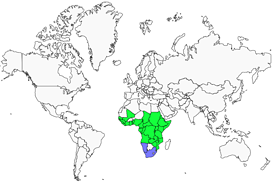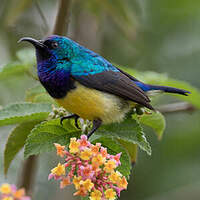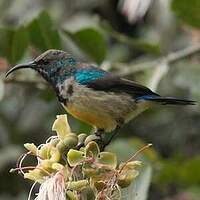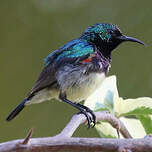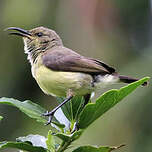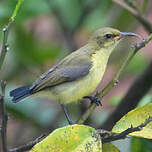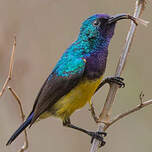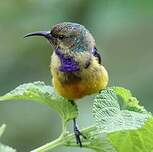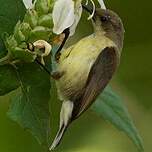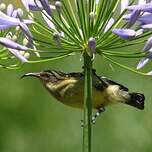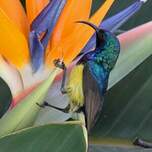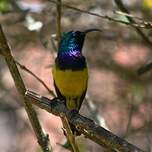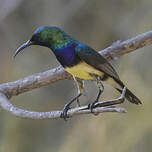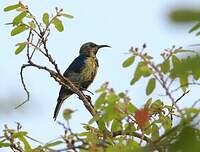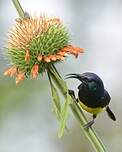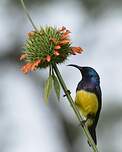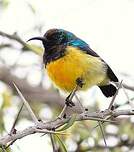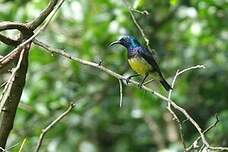Variable Sunbird
Cinnyris venustus - Souimanga à ventre jaune
Identification
The Variable Sunbird is a small sunbird (10 cm), with a beak that is slightly shorter than its head, quite strong and regularly bending downward, and with a very noticeable sexual dimorphism.
The male, in nuptial plumage, is particularly colourful. What stands out at first glance is the stark contrast between its chest of a bright purple edged in black towards the bottom and its light coloured belly (white, yellow, or orange, depending on the subspecies). A purple colour is also present on its forehead and chin. The lores are black. Yellow and/or red tufts are visible on either side of the chest in certain circumstances, on the wrist of the wing. Viewed from behind, it displays upper parts (the back of its head, neck, mantle, back, rump, lesser and greater coverts) in a bright green or blue-green. The rest of the wing is dark brown and the greater coverts are bordered by blue-green. The greater tertials are brightly blue and the tail is black, nicely tinted with blue. The legs and beak are black; the iris is dark brown.
The female, smaller than the male, has a much more discreet and less glossy plumage. The upper parts are of a quite cold brown-grey, tinged with olive depending on the subspecies and the individual. The wings are of a middle brown colour and the tail, a blackish glossy blue, is bordered and finished with whitish. A pale yellowish eyebrow, hardly visible, outlines the dark eye. The lores are dark brown. The underside of the type subspecies is pale yellow, fading to whitish along the throat and lesser coverts.
Young ones resemble their mother, without the light areas on the tail. A bit later, a young male will be differentiated by its throat marked by a longitudinal dark band.
The 5 subspecies are mainly distinguished by the colour of the male's belly, which can range from white to orange, hence the English specific name Variable Sunbird.The albiventris subspecies, found in the Horn of Africa, is the least colourful of the 5. Yellow is absent from the plumage, in both the male and female. The belly is white and in the female, there is no olive hue on the back. The most colourful is the ssp igneiventris whose male has, as its name suggests, its upper belly the colour of fire and scarlet tufts on the pectoral.
In the south of the continent, one of the subspecies has two ecological groups of birds that are distinctly different. This is an illustration of a process of speciation that, in time, could lead to new taxa.
Subspecific information 5 subspecies
- Cinnyris venustus venustus (Senegal and Gambia to Sierra Leone and east to n Cameroon and Central African Republic)
- Cinnyris venustus fazoqlensis (e Sudan, Eritrea and n and w Ethiopia)
- Cinnyris venustus albiventris (e and s Ethiopia, Somalia and ne Kenya)
- Cinnyris venustus falkensteini (Gabon and w Angola to w Kenya, Tanzania and Mozambique)
- Cinnyris venustus igneiventris (e DRCongo, Uganda, Rwanda and Burundi)
Foreign names
- Souimanga à ventre jaune,
- Suimanga variable,
- nectarínia-de-barriga-amarela,
- Ziernektarvogel,
- karcsú nektármadár,
- Ornaathoningzuiger,
- Nettarinia variabile,
- variabel solfågel,
- Venussolfugl,
- nektárovka ozdobná,
- strdimil proměnlivý,
- Savannesolfugl,
- keltavatsamedestäjä,
- Geelpenssuikerbekkie,
- suimanga variable,
- nektarnik fioletowy,
- Разноцветная нектарница,
- カワリタイヨウチョウ,
- 杂色花蜜鸟,
- 易變花蜜鳥,
Voice song and cries
The song of the Variable Sunbird is characterized by short phrases such as te-tch-weee, rising or falling, repeated 3 or 4 times and followed by quick ch trills. Some variations are noted: tsrrr followed by tschi-pu. The calls are chip-chip, chop tsee-tsk-tsk, tser-tze-zip and tew-tew-tew. Finally, the alarm cries are cheer-cheer or tshwee, tshwee, tshwee.
Habitat
The Variable Sunbird is not too demanding when it comes to its arboreal habitat. It is found in both wild wooded environments such as savanna, Brachystegia forests, Mopane forests in the south, etc.
Behaviour character trait
The Variable Sunbird is mostly active in the morning and late afternoon and spends its time flying from flower to flower in search of the nectar it feeds on or hunting for small insects it catches on the wing or on foliage, consuming its catches away from the crowd.
It has good night vision that allows it to feed at night as well.The species is sedentary, but it seems to be subject to altitude movements that are not well understood due to climatic conditions (temperature, rainfall). It favors wet areas over arid ones. It is generally found in pairs regardless of the time of year or in small family groups. It easily mingles with other species of birds for the purpose of finding food.
Dietfeeding habits
As with all Sunbirds, the Variable Sunbird feeds on the nectar from many flowers, including the long, closed flowers of Tapinanthus globiferus, which it opens itself with its beak. It is also fed on small insects, larvae or imagos, and spiders. It looks for them on the ground, digging with its beak, but mostly in flight. It gathers insects while hovering among tall grasses or reeds. The spiders, on the other hand, are usually taken straight from their web.
Reproduction nesting
The Variable Sunbird is monogamous. The female undertakes alone the construction of the nest which can require 10 to 20 days of work.
She hangs it on large grasses or a shrub branch, at a height of 2 to 9 m. Sometimes she chooses unusual places, recently burned woods, abandoned buildings, ... Oval in shape, it is composed of fine vegetable organs, bristles, rootlets, dry linear leaves, various fibers, or even fresh leaves and flowers. All this is held by spider silk threads. The round entrance hole is located on the side, protected by a small ledge. The female lines the inside of the nest with soft elements such as the aerial dispersion organs of clematis or silver thistle seeds.Its laying occurs throughout the year within the nesting area, but at different periods depending on the region. Second lays are known. The female lays one to three white-grayish eggs strongly mottled with gray brown and brown. She incubates alone for 14 days. The structure of the nest and the materials used to line the inside allow for good internal temperature and give the female the opportunity to go away in the morning and in the evening to feed herself. During the time of nesting and incubation, the male takes care of the defense of the territory, singing on strategic perches. He will then join the female to feed the chicks for about fifteen days. After which, the young will leave the nest but will remain dependent on the two parents for some time. The nest of the Variable Sunbird is parasitized by the Klaas's Cuckoo.
Geographic range
The Variable Sunbird is exclusively African. Its distribution area can be divided into three sets. The first goes from Senegal to the Central African Republic in a strip along the coast. The second occupies the eastern part of the continent, from Eritrea to Tanzania and from the Horn of Africa to the east of the DRC. Finally, a last block is located in the south-center, from the south of the DRC to Zimbabwe and from Angola to Mozambique. No migratory movements are known of it.
Threats - protection
IUCN conservation status
concern
in the Wild
threatened
evaluated
The Variable Sunbird is common across most of its range and is not threatened. It is however rare in the extreme south of its range. It is found in majority of the protected areas, which is beneficial for conservation of the species.
Sources of information
- IOC World Bird List (v14.1), Gill, F and D Donsker (Eds). 2023.
- Sunbirds, Roberts A. Cheke, Clive F. Mann and Richard Allen
- Birds of Southern Africa, Tony Roocroft
- HBW Alive,
- Biodiversity explorer The web of life in Southern Africa,
Other sources of interest
 Specification sheet created on
22/07/2023 by Nathalie Santa Maria
Specification sheet created on
22/07/2023 by Nathalie Santa MariaTranslation by AI Oiseaux.net
published: 24-07-2017 - Updated: 10-08-2017
© 1996-2024 Oiseaux.net
- Accipitriformes
- Aegotheliformes
- Anseriformes
- Apodiformes
- Apterygiformes
- Bucerotiformes
- Caprimulgiformes
- Cariamiformes
- Casuariiformes
- Charadriiformes
- Ciconiiformes
- Coliiformes
- Columbiformes
- Coraciiformes
- Cuculiformes
- Eurypygiformes
- Falconiformes
- Galliformes
- Gaviiformes
- Gruiformes
- Leptosomiformes
- Mesitornithiformes
- Musophagiformes
- Nyctibiiformes
- Opisthocomiformes
- Otidiformes
- Passeriformes
- Pelecaniformes
- Phaethontiformes
- Phoenicopteriformes
- Piciformes
- Podargiformes
- Podicipediformes
- Procellariiformes
- Psittaciformes
- Pterocliformes
- Rheiformes
- Sphenisciformes
- Steatornithiformes
- Strigiformes
- Struthioniformes
- Suliformes
- Tinamiformes
- Trogoniformes

